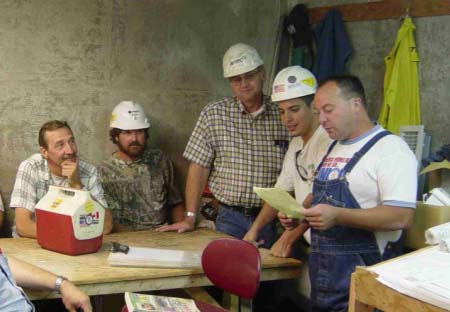AMEC Construction Partnership implements safety and health management systems and reduces injury and illness incident rate
Success Impact:
Safety and Health Management System Components Implemented
As a result of the AMEC Construction Partnership (Partnership), started in April 2002 and originated in the Calumet City, Illinois OSHA Area Office, comprehensive safety and health management systems have been developed and implemented at participating job sites. These systems include management leadership and employee involvement, worksite analysis, hazard prevention and control, and safety and health training. Examples have included the following activities at this Partnership:
- project-specific safety and health orientation training for new hires at job sites, including training on personal protective equipment, fall protection, electrical safety, excavation, accident reporting, emergency response, on-the-job conduct, and site-specific training topics;
- daily site audits and weekly assessments that include the identification and correction of hazards;
- weekly tool box talks with mandatory employee attendance, during which site audit and assessment results are reviewed; and
- investigation of near miss incidents with results shared with OSHA and other job sites in the Partnership.
To date, over 2,000 employees have received training through the tool-box talks and new hire orientations.
Injury and Illness Rate Declines
Even though AMEC Construction's injury rate was well below the industry average, the company strove for continual improvements and embraced the Partnership as the next logical step in this process. Since the Partnership began in April 2002, the total recordable case incident rate for participating AMEC subcontractors has declined from 9.1 in 2002 to 2.8 in 2004, a 69 percent reduction. This 2004 rate of 2.8 is 59 percent below the 2002 non-residential construction industry national average of 6.9.
|
Total Recordable Case Incident Rate |
Percent Below National Average |
Days Away From Work, Job Transfer or Restriction |
Percent Below National Average |
|---|---|---|---|
|
2.8 (2004 YTD) |
59% |
1.6 (2004 YTD) |
53% |
Safety Culture Enhanced
In addition to the reduction in injuries, Partnership-related improvements have contributed to an enhanced safety culture for the projects covered by the Partnership. One subcontractor has noted a greater sense of ownership by workers at the job site, who see themselves as key contributors to the project and have increased pride in their workmanship. The Partnership activities are especially beneficial to younger trades people, such as electricians and plumbers, because the activities reinforce the safety training undertaken during their apprenticeships. Subcontractors and trades people also benefit from an enhanced relationship with OSHA and have come to understand that the agency is approachable.
Overall, the Partnership has emphasized a cooperative safety and health relationship among AMEC, OSHA, and AMEC's subcontractors at large job sites in the Partnership, which has improved communication at those job sites and allowed any safety incidents to be addressed immediately.
A "win-win situation"
Andrew Schaeffer, AMEC's Central Region Safety Manager, says that in the Chicago area the Partnership "has been a win-win situation in that we have decreased incident rates across the board and received no citations since the inception." Gary Anderson, the Area Director of OSHA's Calumet City, Illinois office, calls the AMEC/OSHA Partnership "a good example of how government and the private sector can work together cooperatively to bring about a safe work environment."
Initiatives Extended to Other Organizations and Job Sites
After its initial successes in the Chicago area, AMEC has extended Partnership initiatives to job sites in other cities, including New York, Boston, and San Francisco. Additionally, organizations such as building trades and insurance carriers and brokers have taken lessons learned on AMEC sites and carried them to other projects.

AMEC contractor employees attend one of the weekly "Tool Box Talks."
Partnership Objectives:
OSHA and AMEC Construction Management, Inc. have partnered to reduce work-related fatalities and serious injuries in the construction industry. The hazards in the construction industry are well documented and often increase in complexity at multi-employer worksites, such as those found in many high-rise or complex industrial projects. The Partnership seeks to reduce those hazards and prevent serious accidents through the implementation of enhanced safety and health management systems and recognition of those subcontractors with exemplary safety and health management systems. Through the development of a contractor/government relationship, the Partnership encourages subcontractors to improve their safety and health performance and assists them in seeking to eliminate the four hazards (falls, electrical, caught in/between and struck-by hazards) that account for the majority of fatalities and injuries in the construction industry and have been the focus of targeted OSHA inspections. The Partnership's activities are applied to all projects where AMEC acts as the controlling contractor and OSHA has federal jurisdiction.
Origin: Region 5, Calumet City, Illinois Area Office
Partners: AMEC Construction Management, Inc. (AMEC); OSHA; Compliance Safety Advocates, Inc.; and various subcontractors at AMEC sites.
Partnership Signed: April 2002; Partnership Renewed in January 2003
Industry (NAICS Code): Construction (NAICS Code 23332, SIC Code 154)
Employees: Varies, depending on building project cycles
Employers: Varies
Source (Date): Andrew Schaeffer, Central Region Safety Manager, AMEC Construction Management, Inc. (October 2004).

Representatives of AMEC, the construction trades, and OSHA at the Partnership's July 23, 2003 meeting.
Front Row (left to right): Gary DiPaolo, Vice President Safety and Health, AMEC; Gary Anderson, Area Director OSHA Calumet City; Kathy O'Connell, Assistant Area Director, OSHA-Calumet City (standing); Rick Harbour, President, Compliance Safety Advocates; Andrew Schaeffer, Territory Safety Manager, AMEC-Central Region; Doug Anderson, Site Safety Manager, Compliance Safety Advocates. Back Row (left to right): Joe Knaff-OSHA, Craig Jorsch-Local 150, Scott Chinn-AFI, Michael Kennedy-AFI, Mona Block-Climatemp, Michael Clifford-Great Lakes Heating & Plumbing, Kevin Johnson-AMEC, Jim Lindquist-AFI, Steve Becker-Gibson Electric, Tom Barilich-AIG, Joe Charczencko-Zurich, Pete Portikis-MTH Industries, Tim Janis-Zurich, Tom Kavicky-UBC, Kenneth Borg-UBC, George Barton-CSA, and Kurt Krueger-CSA


